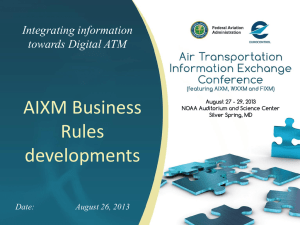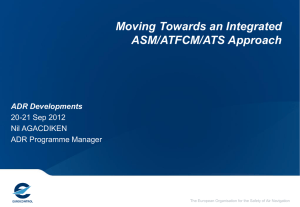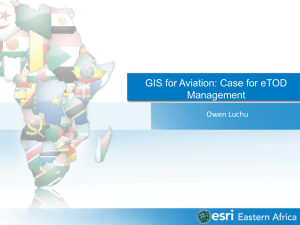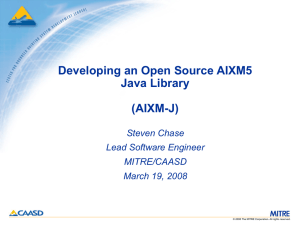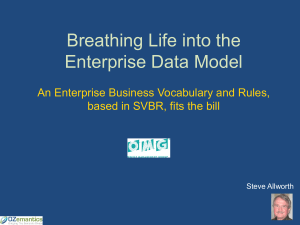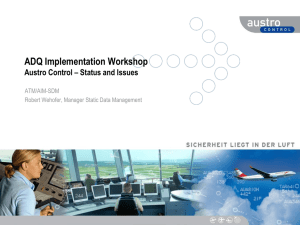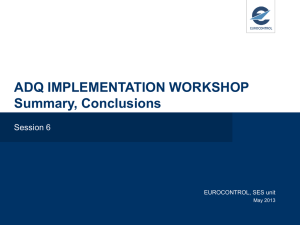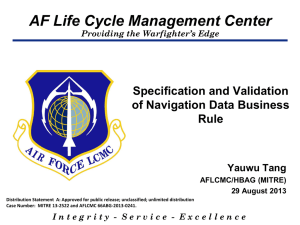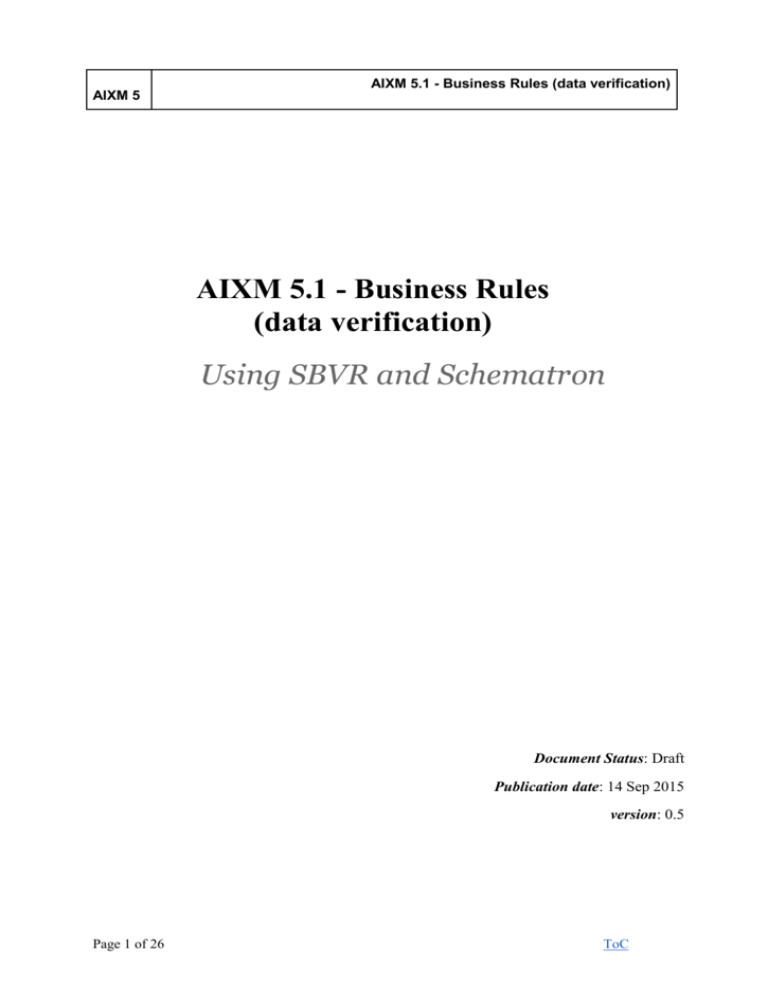
AIXM 5
AIXM 5.1 - Business Rules (data verification)
AIXM 5.1 - Business Rules
(data verification)
Using SBVR and Schematron
Document Status: Draft
Publication date: 14 Sep 2015
version: 0.5
Page 1 of 26
ToC
AIXM 5.1 - Business Rules (data verification)
AIXM 5
Aeronautical Information Exchange Model
(AIXM)
Copyright: 2015 - EUROCONTROL and Federal Aviation Administration
All rights reserved.
This document and/or its content can be downloaded, printed and copied in whole or in part, provided that the above
copyright notice and this condition is retained for each such copy.
For all inquiries, please contact:
Eduard POROSNICU - eduard.porosnicu@eurocontrol.int
Edition
Status
Issue Date
Reason for Change
0.1
Working Draft
25 July 2013
Initial working draft. Derived from previous
work by Pulsar Consulting (under contract
for Eurocontrol) and from the “Guidance
on Writing AIRM Constraints” - SESAR
Project 08.01.03 deliverable, which is itself
based on the previous Eurocontrol worl
0.2
Working Draft
05 August 2013
Updated after initial attempts to use the
instructions and after discussion with
group members, in particular issues raised
by Michal Kadlec
0.3
Draft
09 June 2014
First public release, intended for a wider
review. Also including an introductory part
explaining the need for business rules, the
experience of the previous AIXM model
version and the approach proposed for
AIXM 5
0.4
Draft
15 June 2015
Second public release. Minor editorial
changes. Some new keywords added.
Further details about how to write paths to
target NounConcepts. First examples of
profiles.
0.5
Draft
14 September 2015
Updated public release. No significant
changes to the document, just small
editorial corrections. Issued together with
Page 2 of 26
ToC
AIXM 5.1 - Business Rules (data verification)
AIXM 5
version 0.5 of the rules.
Contributors
This document is the result of consultation with many specialists, in particular from industry. Their
contribution is hereby acknowledged.
Name
Organisation
CLAY Michael
Frequentis
CHUMAKOV Marina
CNA (under contract for US FAA)
DRUARD Sophie
Pulsar Consulting
ECHTERHOFF Johannes
Interactive Instruments
FABBRI Davide
IDS
GERMAIN Francois
Thales
GHENCEA Andrei
Eurocontrol (trainee)
GROBSCH Volker
MClick
HAAS Markus
Comsoft
d’HULST Jean-Christophe
Pulsar Consulting
KADKLEC Michal
Avitech
POROSNICU Eduard (editor)
Eurocontrol
RAZOV Aleksandr
Monitor Soft
SANCHEZ Antonio
GroupEAD
SCHEIDER Markus
MClick
SCHEUCHER Wolfgang
Solitec
SUZIC Robert
Eurocontrol
TANG Yauwu
MITRE Corporation
WALTL Michael
Frequentis
WILSON Scott
Eurocontrol
Page 3 of 26
ToC
AIXM 5.1 - Business Rules (data verification)
AIXM 5
Table of contents
Contents
Executive Summary ........................................................................................................................................... 6
1.
2.
Introduction ................................................................................................................................................ 7
1.1.
The need for Business Rules .............................................................................................................. 7
1.2.
How to read this document ................................................................................................................ 7
Rules definition using SBVR ..................................................................................................................... 8
2.1.
Introduction ........................................................................................................................................ 8
2.2.
SBVR Profile for AIXM .................................................................................................................... 8
2.2.1.
SBVR concepts .......................................................................................................................... 8
2.2.2.
NounConcept - special situations ............................................................................................. 11
2.2.3.
Verb concept - special situations.............................................................................................. 12
2.2.4.
Logical Operations ................................................................................................................... 13
2.2.5.
Quantification........................................................................................................................... 13
2.2.6.
Modality ................................................................................................................................... 14
2.2.7.
Additional SBVR keywords..................................................................................................... 15
2.2.8.
Additional Fact-types ............................................................................................................... 16
2.3.
3.
Methodology .................................................................................................................................... 18
Schematron test implementation .............................................................................................................. 20
3.1.
Introduction ...................................................................................................................................... 20
3.2.
Schematron code - technical aspects ................................................................................................ 20
3.2.1.
XPath version ........................................................................................................................... 20
3.2.2.
Use of Java extensions ............................................................................................................. 20
3.2.3.
Feature references in the Schematron code .............................................................................. 20
3.2.4.
Content of the Excel file .......................................................................................................... 20
3.3.
Practical verification of AIXM data sets.......................................................................................... 21
Page 4 of 26
ToC
AIXM 5.1 - Business Rules (data verification)
AIXM 5
3.3.1.
4.
5.
Testing...................................................................................................................................... 21
AIXM Business Rules data set................................................................................................................. 22
4.1.
Excel file .......................................................................................................................................... 22
4.2.
Profiles ............................................................................................................................................. 22
4.2.1.
EAD Data Provider .................................................................................................................. 22
4.2.2.
Event profile............................................................................................................................. 22
4.2.3.
Event_FAA profile................................................................................................................... 22
4.2.4.
Minimum air navigation data set profile .................................................................................. 22
4.2.5.
Full air navigation data set profile ........................................................................................... 23
References ................................................................................................................................................ 24
Annex A - License and Disclaimer .................................................................................................................. 25
Page 5 of 26
ToC
AIXM 5
AIXM 5.1 - Business Rules (data verification)
Executive Summary
This document defines the AIXM 5.1 approach to “business rules” - how they are modelled and how they are
provided to system developers. Such rules can be used to verify if AIXM XML data sets that are
syntactically valid (against the AIXM XML Schema) are also semantically correct and can be used in
confidence for a particular application.
The objective of the AIXM Business Rules project is to provide an exhaustive set of business rules.
However, only a subset of these rules might be relevant and need to be enforced/checked for a particular
application. For example, a rule that concerns mandatory feature properties indicates that the frequency of a
navaid is a required value. While for a charting or air navigation support application this is a necessary
constraint, for a flight planning application this is not necessary. Therefore, profiles of this general-purpose
set of AIXM business rules will be proposed for particular applications and/or AIXM user communities.
The Semantics of Business Vocabulary and Business Rules (SBVR) [1] standard is applied for writing the
AIXM business rules. in relation with the AIXM UML logical data model. This document provides an
‘SBVR profile’, which is tailored to the AIXM needs and which is documented as a number of concepts and
conventions applied in the writing of the AIXM business rules. This document is not intended as an
exhaustive introduction in SBVR; it is mostly a “primer” document, giving the essential elements that need
to be understood in order to:
● contribute to the writing of the AIXM 5.1 Business Rules in compliance with the SBVR
methodology;
● read and understand the AIXM 5.1 Business Rules by those interested to review and/or implement
such rules in a given system.
In addition to the SBVR definition, the general-purpose set of AIXM Business Rules provided with this
document also includes a Schematron [4] encoding of most of these rules. This is done for two reasons:
● in order to verify that the SBVR description of the rule is sufficiently clear and unambiguous in
order permit its actual implementation as software code;
● to offer practical means by which an AIXM data set could be verified against the business rules,
using software readily-available on the Web, most of it for free.
However, it shall be kept in mind that this Schematron encoding is missing for some rules for which the
encoding is expected to be very complex or even impossible. In addition, any use of the Schematron coding
provided with the AIXM Business Rules is subject to the license and disclaimer copied in Annex A.
Page 6 of 26
ToC
AIXM 5.1 - Business Rules (data verification)
AIXM 5
1.
1.1.
Introduction
The need for Business Rules
The Semantics of Business Vocabulary and Business Rules (SBVR) [1] standard defines business rules as
being “a law or principle that operates within a particular sphere of knowledge, describing, or prescribing
what is possible or allowable” and that is also under the jurisdiction of a particular business. In the AIXM
case, that jurisdiction is the aeronautical information domain. The aim of defining the AIXM Business Rules
is to define what is possible or allowed in an AIXM data set, in particular with regard to data values.
The AIXM UML model defines the information items that are in the scope of the “aeronautical information”
domain using UML class diagrams. This includes definitions for classes, attributes and associations between
classes. For attributes, the constraints expressed as lists of values, range of values, pattern are also included
in the AIXM UML model.
The AIXM XML schema is derived from the UML model and defines elements that correspond to the AIXM
model classes, attributes and association role names. The values of XML elements and data types derived
from UML attributes are constrained based on the data types defined in the UML model - list of values, data
ranges and/or patterns.
More complex constraints, such as dependencies between the values of different attributes (sometimes in
different classes), detection of ‘out of range’ values, mandatory properties for class of objects, etc. are not
included in the UML model and do not appear in the XML Schema. Thus the need to document such more
complex constraints as “business rules”.
Not all the AIXM Business Rules defined in this document are equally applicable in all communities of
AIXM users. The most obvious examples are mandatory properties for AIXM features - in a flight planning
community, there is no need to include in an AIXM data set the frequency/channel of a navigation aid. On
the other side, such attributes are mandatory for data sets provided to an air navigation community.
Therefore, the aim of this document is to document the largest possible set of candidate AIXM business
rules, from which profiles for a particular community can be extracted. Such profiles are proposed in the
AIXM Business Rules data set chapter and the related Annexes.
1.2.
How to read this document
Operational/domain experts are recommended to read the Executive Summary, the Introduction and Rules
definition using SBVR (in particular the Methodology section). Then, go directly to the AIXM Business
Rules data set chapter.
The Schematron reference implementation chapter is intended for developers. However, it should be kept in
mind that the use of Schematron is not the only option available for the implementation of the AIXM 5.1
business rules. The Schematron code will provided where possible (as an estimation, for 80% of the rules) as
an example only.
Page 7 of 26
ToC
AIXM 5.1 - Business Rules (data verification)
AIXM 5
2. Rules definition using SBVR
2.1.
Introduction
The Semantics of Business Vocabulary and Business Rules (SBVR) [1] standard is used for the writing of
the AIXM business rules in relation with the AIXM UML logical data model. This section defines an ‘SBVR
profile’, which is tailored to the AIXM needs and which is documented as a number of concepts and
conventions applied in the writing of the AIXM business rules. Two previous projects have provided input
material for this document:
● work done by Pulsar Consulting, under contract for Eurocontrol, which is available on the AIXM
wiki: Use of SBVR for AIXM [2];
● Guidance on Writing AIRM Constraints [3] provided by SESAR Project 08.01.03.
This document is not intended as an exhaustive introduction to SBVR. Apart from reading the full SBVR
specification [1], the following ‘SBVR essentials” reading list is suggested:
● the first pages in Chapter 10 of the OMG SBVR specification [1] version 1.1;
● this presentation available in the Web (in particular slides 5 and 6).
2.2.
2.2.1.
SBVR Profile for AIXM
SBVR concepts
The following table introduces the concepts used as part of the SBVR Profile for AIXM, including their
graphical notation. Note that the use of some graphical notations is simplified as compared to the SBVR
standard, such as double underline which is replaced with simple underline. This facilitates the use of
standard office tools (such as Microsoft Excel) for the provision of the AIXM set of Business Rules.
Concept
NounConcept
SBVR Definition:
● Unit of knowledge created by a unique combination of characteristics.
Representation in profile:
● Not represented – too general
SBVR Definition:
● Concept that is the meaning of a noun or noun phrase.
Representation in profile (i.e. what AIXM items may appear as NounConcept
according to the SBVR profile):
● Represented by AIXM UML Classes and Properties, meaning that AIXM Class
Name, Role Name or Attribute Name may appear as NounConcept. Due to
specificities of the AIXM UML model, some special constructs are explained
in the NounConcept - Special situations section.
Style: Bold, underlined and UpperCamelCase or lowerCamelCase (depending on
how the noun concept appears in the UML model). If several nouns are concatenated,
then they should be separated by a dot (“.”) symbol.
Page 8 of 26
ToC
AIXM 5.1 - Business Rules (data verification)
AIXM 5
Colour: #008080
Example: AirportHeliport, Airspace.type, AirportHeliport.name,
Runway.associatedAirportHeliport
Verb-concept
also known as
“Fact type”
SBVR Definition:
● Concept that is the meaning of a verb phrase that involves one or more noun
concepts and whose instances are all actualities.
Fact is a proposition that is taken as true.
<Fact-type> :: = <concept1> <verb> <concept2>
Verb Concepts:
● Business Facts
● Relations amongst Concepts
Representation in profile (i.e. what AIXM items may appear as Verb-concept according
to the SBVR profile):
● Represented by Name of an AIXM UML association.
Style: italic
Colour: #0000ff
Example: AirportHeliport has name, Runway hasSurfaceDescribedBy
SurfaceCharacetistics.
Name
SBVR Definition:
● Name is concept that corresponds to only one object [thing] used for the
designation of an individual concept — a name. Names tend to be proper
nouns.
Representation in profile (i.e. what AIXM items may appear as Name according to the
SBVR profile):
● Represents UML Instances, Slots, Enumeration literals, and their assigned
Properties
● CodeList values
Style: surrounded by ‘simple quotes’
Page 9 of 26
ToC
AIXM 5.1 - Business Rules (data verification)
AIXM 5
Colour: #339966
Example: ‘Sweden’, ‘CTA’, ‘CTA_P’, ‘YES’, ‘NIL’
Note that ‘NIL’ is an additional Name concept used in the SBVR profile for AIXM. It
indicates a void property (i.e. a property that does not have a value).
Note: Sometimes, it is necessary to provide a “list of names” (such as ‘A’, ‘B’ or ‘C’)
in order to indicate the allowed values for a property (which appears as a NounConcept
in SBVR rules). The following style shall be used: opening-bracket, followed by each
Name-value surrounded by simple quotes, separated by comma and ending with
closing-bracket.
Example: (‘A’,‘B’,‘C’) (note that the quotes and the brackets are also formatted, just to
keep the editing simple)
keyword
SBVR Definition
● are used to construct statements – the words that can be combined with other
designations to form statements and definitions, see sections on Logical
Operations, Quantification, Modality and Additional SBVR keywords, all these
being part of the keyword concept.
Representation in profile:
● No particular mapping to UML model elements
Style: Usual text format
Colour: #ff9900
Example: Each - referring to universal quantifier.
Page 10 of 26
ToC
AIXM 5.1 - Business Rules (data verification)
AIXM 5
2.2.2.
NounConcept - special situations
When writing AIXM business rules in SBVR, apart from the simple cases where a class/role/attribute name
is used, there are also some special cases, when several classes/associations are involved, as detailed in the
following table.
Special case
NounConcept construction rules
Concatenation - when necessary to identify an
UML model element that is remote from the
current class. For example, a rule defined for
the Runway class that needs to refer to the
type attribute of the AirportHeliport class
The “.” symbol is used as separator between the
concatenated noun concepts. The relative path needs to
include all the intermediate association role names and
class names, as in the following example:
associatedAirportHeliport.AirportHeliport.type
Note that the separator is also formatted, just to keep the
editing simple, although it is not part of respective noun
concept.
Association classes - Some associations are
qualified by a number of properties depicted
inside an ‘association class’. For example, the
association between AirspaceVolume and
another Airspace includes the
AirspaceVolumeDependency association class.
When the NounConcept is inside the association class, the
path includes first the name of the association role,
concatenated with the association class name and with the
property name concerned. For example:
contributorAirspace.AirspaceVolumeDependency.depe
ndency
Classes with <<choice>> stereotype
Classes with <<choice>> stereotype are considered
‘transparent’ and are ignored. However, the role name of
such classes is included in the path to the target
NounConcept in order to align the SBVR text as much as
possible with the XML Schema and to avoid confusions in
case a choice would refer to the same class with separate
roles. For example, the following path is used:
EnRouteSegmentpoint.location_fixDesignatedPoint.Desi
gnatedPoint, etc.
Data type attributes - For example, most
“Val…” data types come with a “uom”
attribute.
The uom attribute appears directly in the path after the
attribute name, prefixed with a ‘.’. For example, the rules
that require the mandatory presence of a uom value for an
elevation attribute use the following noun concept path:
elevation.uom.
TimeSlice - Not present in the UML model, but To be added
appearing directly in AIXM XML Schema,
based on the AIXM Temporality Concept (see
in particular section 2.8 in that document). For
example, a rule that prevents the change of an
Airspace type (and FIR should not become a
CTR or a D area), might need to refer to a
Page 11 of 26
ToC
AIXM 5.1 - Business Rules (data verification)
AIXM 5
specific type of TimeSlice (PERMDELTA or
TEMPDELTA).
GML elements - Present only partially in the
UML model, through the GM_… classes.
However, the details of these classes are
missing in AIXM 5.1. For example, positions
are encoded with the gml:pos element, while
surfaces use much deeper structures, such as
gml:Surface.gml:...
2.2.3.
To be added
Verb concept - special situations
When writing AIXM business rules in SBVR, apart from the simple cases where an association name is used
directly as verb concept, there are also some special cases, as detailed in the following table.
Special case
“has” as fact type
attributes of a class
Verb-concept (fact type) construction rules
for
the There is an implicit association (fact type) between a class and each of
its attributes. This can be expressed using both the is property of or the
has fact type (depending on direction in which the rule is written). For
example: “name is property of AirportHeliport” or “Airspace has
type”. Although they do not appear explicitly in the model as
associations, they can be used in this formulation and are declared by
the profile itself as “additional-fact-types”.
“has” as fact type for the The AIXM UML model makes a difference between <<feature>> and
properties of an associated <<object>> classes (stereotype). An <<object>> is seen as a complex
property of another class. Therefore, "has" can be used as a simplified
<<object>> class
fact-type in situation such as the following:
Airspace has geometryComponent.AirspaceVolume.upperLimit
(“has” followed by the role name of the target class is used instead of
the feature-object association name “hasGeometry”)
AirportHeliport has servedCity.City.name
(“has” followed by the role name of the target class is used instead of
the feature-object association name “serves”)
However, the "has" fact-type cannot be used when referring to the
properties of another <<feature>> class, because the two exist
independently from each other. They have a different timeline and
traversing the association requires also selecting the relevant
TimeSlices. This aspect is sufficiently important to be preserved in the
SBVR text. In such situations, the association name must be used:
Runway isSituatedAt AirportHeliport
Page 12 of 26
ToC
AIXM 5.1 - Business Rules (data verification)
AIXM 5
(this cannot be replaced by “Runway has
associatedAirportHeliport.AirportHeliport”!)
Classes
stereotype
2.2.4.
with
<<choice>> Classes with <<choice>> stereotype are considered ‘transparent’ and
are ignored. For example, the following facts are established by the
model: EnRouteSegmentpoint isLocatedAt Navaid,
EnRouteSegmentpoint isLocatedAt DesignatedPoint, etc. The
intermediate SignificantPoint <<choice>> is ignored.
Logical Operations
The following table introduces the logical operations (e.g. “and”, ”not”, “or”, etc.) used in the SBVR Profile
for AIXM. The exact representation of the operations is in the third column (using keywords convention).
Note: the keywords marked with an * sign are not used for the moment. They are kept for completeness sake,
some might become necessary later.
Logical Operation SBVR Profile for ATM Meaning
Representation
conjunction
p and q
True when all operands are true
disjunction
p or q
True when at least one operand is true
equivalence*
p if and only if q
True when operands are either all true or all false
exclusive
p or q but not both
One operand is true and the other is false
disjunction*
implication
if p then q
binary logical operation that operates on an antecedent
and a consequent and that formulates that the meaning of
The following equivalent the consequent is true if the meaning of the antecedent is
formulation is sometimes true
used in this profile in
order to improve the
readability of the text:
logical negation
nand*
nor*
whether or not*
2.2.5.
“Each… shall…”
not p
not both p and q
neither p nor q
p whether or not q
True when the operand is false
true when at least one operand is false
true when all operands are false
binary logical operation that has a consequent and an
inconsequent and that formulates that the meaning the
consequent is true regardless of the meaning the
inconsequent.
Quantification
The following table introduces the quantifications (e.g. “at least one”) used as part of the SBVR Profile for
AIXM. The third column contains the representation (using keywords convention).
quantifier
SBVR Profile
logic
description
name
for ATM
symbol
Page 13 of 26
ToC
AIXM 5.1 - Business Rules (data verification)
AIXM 5
universal
Representation
each x
∀
For each and every x, taken one at a time
existential
at least one x
∃
At least one x
exactly-one
exactly one x
∃1
There is exactly one (at least one and at most
one) x
at-most-one
at most one x
∃0..1
There is at most one x
at-most-n
at most n x
∃0..n
There is at most n x Note: n is always
(n ≥ 1)
instantiated by a number ≥ 1. So this is
really a set of quantifiers (n = 1, etc.)
at-least-n
at least n x
∃n..
There is at least n x Note: n is always
(n ≥ 1)
instantiated by a number ≥ 1. So this is
really a set of quantifiers (n = 1, etc.)
at-least-2
more than one x
∃n..
(n = 2)
There is at least 2 x.
exactly-n
exactly n x
∃n
There is at exactly (at least and at most) n x Note:
(n ≥ 1)
numeric range
at least n and at
most m x
∃n..m
n is always instantiated by a number ≥ 1. So
this is really a set of quantifiers (n = 1, etc.)
There is at least n and at most m x
(n ≥ 1)
(m ≥ 2)
2.2.6.
Modality
The following table introduces the modalities (e.g. “It is obligatory”) used in the SBVR Profile for AIXM.
The fourth column details the representation in the profile.
Note: the keywords marked with an * sign are not used for the moment. They are kept for completeness sake,
some might become necessary later.
Modality
SBVR Profile for ATM
Reading (Verbalised as)
after applying
transformation using
negations:
It is obligatory that p
It is not permitted that
obligation
not p
The following formulations are used in this profile in order
to distinguish between a strict and loose enforcement of an
obligation (based on the ICAO practice):
p shall …
p should ...
Page 14 of 26
ToC
AIXM 5.1 - Business Rules (data verification)
AIXM 5
“shall” = obligation with strict enforcement level
“should” = obligation with loose enforcement level
prohibition
(negation of
permission)
It is prohibited that p
It is obligatory that not p
In relation with the two forms of obligation (strict and
loose enforcement,, based on the ICAO practice), the
prohibition formulation can also take two forms:
p shall not …
p should not ...
Note: Please be aware of the distinction between the use of the phrases “It is obligatory that”/”It is
prohibited that” and the pattern “Each...shall/should”. The latter implies that the target entity or attribute
has to exist, whereas this is not always the case. Therefore, the negative formulation is preferred in most
cases, as it will check the value only when the entity or the attribute is actually present.
Example:
Each Runway with assigned lengthStrip value shall have assigned lengthStrip.uom value equal-to (‘FT’,’M’)
versus
It is prohibited that a Runway with assigned lengthStrip value has lengthStrip.uom value not equal-to ('FT','M')
2.2.7.
Additional SBVR keywords
The following table introduces additional keywords that are used in this Profile.
Keyword
Explanation
Way of use in SBVR AIXM Profile
a, an
universal or existential quantification
depending on context based on English rules
assigned
value
existential quantification (that the referent for readability reasons (and to comply with
thing is not null)
the English language syntax), it is usually
written as follows:
assigned noun-concept value
with
that
has fact type plus a condition on the
property or descendant
used as a simplified form of:
existential quantification for a part of a
condition starting with a verb concept
typically used in front of the verb concept,
between two noun concepts with associated
conditions
p has q and q …some condition for q...
... p… some condition for p… that verb q …
some condition for q …
equal-to
Page 15 of 26
existential quantification plus a condition typically used in front of a Name or a list of
that the referent thing is the same thing as Names, when the item also has to exist
the referent of the term that comes next
ToC
AIXM 5.1 - Business Rules (data verification)
AIXM 5
higher-than existential quantification plus a condition typically used after a noun-concept in the
that the referent thing is a numerical value form of a class attribute that takes numerical
that is larger than the referent of the term values
that comes next
higher-orequal-to
existential quantification plus a condition typically used after a noun-concept in the
that the referent thing is a numerical value form of a class attribute that takes numerical
that is larger than or equal to the referent values
of the term that comes next
lower-than
existential quantification plus a condition typically used after a noun-concept in the
that the referent thing is a numerical value form of a class attribute that takes numerical
that is smaller than the referent of the term values
that comes next
lower-orequal-to
existential quantification plus a condition typically used after a noun-concept in the
that the referent thing is a numerical value form of a class attribute that takes numerical
that is smaller than or equal to the referent values
of the term that comes next
resolved-into existential quantification plus a condition
that the value of the noun-concept that
precedes the keyword corresponds to an
instance of the verb and noun-concept that
come next
other than
2.2.8.
used to indicate the action of evaluating the
value of an association role name instance
and identifying the target feature instance,
taking into consideration the associations
implementation method used (according to
the AIXM Feature Identification and
reference document)
at-most-one quantification plus condition typically used in front of a Name or a list of
that the referent thing is not the same thing Names, when the item may also be null
as the referent of the term that comes next
Additional Fact-types
The following table introduces additional fact-types used in SBVR AIXM Profile. They are ‘additional’ in
the sense that they do not appear explicitly as associative facts in the model.
Note: the fact-types marked with an * sign are not used for the moment. They are kept for completeness sake,
some might become necessary later.
is-property-of
associative fact type that is defined with respect to a first given concept and
a second given concept such that each instance of the fact type is an
actuality that an instance of the first concept constitutes an essential quality
of an instance of the second concept
has
describes the same associative fact as “is-property-of”, but in the opposite
direction: an instance of the second concept constitutes an essential quality
of an instance of the first concept
is-descendant-of
Page 16 of 26
describes a deeper associative fact than “is-property-of”; an instance of the
first concept constitutes a property of a property (and so on…) of an
instance of the second concept
ToC
AIXM 5
has descendant
specialisation
categorization*
is-of-type*
Page 17 of 26
AIXM 5.1 - Business Rules (data verification)
describes the same associative fact as “is-descendant-of”, but in the opposite
direction
categorisation fact type (used to target a specific non-abstract class, that is a
specialisation of a parent class; for example NavaidEquipment
specialisation VOR)
or
contextualisation fact type
a particular instance of the concept is also an instance of the category
is used for expressing units of measurements (UOM)
ToC
AIXM 5.1 - Business Rules (data verification)
AIXM 5
2.3.
Methodology
This section is primarily intended for those involved in the writing of the SBVR text of the AIXM Business
Rules. However, it might also provide interesting hints for the readers of the document, as it shows how a
rule is being developed starting from a fact established by the model, a reference document (such as an
ICAO Annex containing Standards and Recommended Practices) and applying the SBVR methodology.
The starting point for writing the SBVR text of a rule is the AIXM UML model, which describes “fact
types” such as:
● “Runway isSituatedAt AirportHeliport”
● “name is-property-of AirportHeliport”
● etc.
Some of these fact types are documented as associations between classes and there is an explicit verb (the
name of the association, such as “isSituatedAt”). Some others are attributes of a class (and the verb that
describes the fact type is implicitly “is-property-of”). Note that the graphical syntax for NounConcepts and
FactTypes is used in these examples, as described earlier in the document.
When defining business rules, the objective is to capture the various constraints that are used to define
bounds, borders or limits on this set of facts. Any rule shall have at its core a “fact type”. Thus, a recipe for
writing the SBVR text of a rule could be:
● write the rule in operational terms, trying to identify the main class in the AIXM UML model that is
concerned (AirportHeliport, Airspace, Navaid, etc.).
● identify the fact types in the model to which the constraint refers (could be represented as an
attribute of a class, an association of a class, or could be a more complex part of the model,
involving 2-3 classes and their attributes, indirectly related);
● start building the rule text around that fact type:
○ add quantification to each noun concept involved;
○ add logical operations, if more conditions are involved;
○ add modality for the fact type.
For example:
● “It is obligatory that each Runway isSituatedAt exactly one AirportHeliport
● “It is obligatory that exactly one name is-property-of each AirportHeliport”
Keep in mind that obligations come in two forms in the aeronautical information domain: strict (expressed
with “shall”) and loose (expressed with “should”).
The fact type “is-property-of” is maybe easier to understand if written in the opposite direction using
“has/have”.
● “Each AirportHeliport shall have exactly one name”
In fact, the two rules mentioned above are already hard-coded in the AIXM UML model.The real objective
is to document rules that are not already coded in the UML model. For example, a data consistency rule
stating that “a heliport cannot have any associated runway”, is defined following the same steps:
● identify in the AIXM UML model the fact types concerned:
○ Runway isSituatedAt AirportHeliport
○ AirportHeliport has type
● the model already includes the constraint that the type attribute can get a value from a predefined
list: (‘AD’, ‘AH’,’HP’,’LS’,’OTHER’). The value that interests us in this case is ‘HP’ (heliport).
Combining this constraint with the second fact type requires a logical operation: AirportHeliport
has type and type = ‘HP’.
● adding modality and quantification gives the following rule: It is prohibited that a Runway
Page 18 of 26
ToC
AIXM 5
AIXM 5.1 - Business Rules (data verification)
isSituatedAt AirportHeliport and AirportHeliport has type and type = ‘HP’
in his form, the rule might a bit difficult to understand by domain experts. Therefore, it is
recommended that a form (using the keyword “with”) is used: write “AirportHeliport with type=
‘HP’“ instead of “ AirportHeliport has type and type = ‘HP’”.
● Finally, the rule can be written as: “It is prohibited that a Runway isSituatedAt AirportHeliport
with type = ‘HP’”
It could be argued that the rule can be written more clear in the opposite direction: “Each AirportHeliport
with type= ‘HP’ shall not have associated Runway". However, the fact-type established by the model is that
'Runway is situated at Airport'. All associations in the model have directionality. Therefore, it is better to
take this into consideration when writing the rule. In XML, the Runway will point to the AirportHeliport,
therefore the rule can be checked directly from the Runway towards the AirportHeliport.
●
Page 19 of 26
ToC
AIXM 5.1 - Business Rules (data verification)
AIXM 5
3.
3.1.
Schematron test implementation
Introduction
In addition to the SBVR definition, where possible Schematron [4] code is provided for the AIXM Business
Rules provided with this document. This is done for two reasons:
● in order to verify that the SBVR description of the rule is sufficiently clear and unambiguous in
order permit its actual implementation as software code;
● to offer practical means by which an AIXM data set could be verified against the business rules,
using software readily-available on the Web, most of it for free.
It shall be kept in mind that this Schematron encoding is missing for some rules for which the encoding is
expected to be very complex or even impossible. In addition, any use of the Schematron coding provided
with the AIXM Business Rules is subject to the license and disclaimer copied in Annex A.
3.2.
Schematron code - technical aspects
Comprehensive introductions to Schematron are available on the Web, such as [5] Introduction to
Schematron by Mulberry Technologies, Inc.
3.2.1.
XPath version
The Schematron code is in principle limited to XPath 2.0 “basic” conformance level, which is a W3C
recommendation since January 2007 and is much richer than XPath 1.0.
Practically, this is ensured by checking that the Schematron code is usable with the XPath subset supported
by the latest Saxon-HE version (using the ISO Schematron implementation for XSLT-2.0).
3.2.2.
Use of Java extensions
Java extensions are used in order to provide functions that would be hard, if not impossible, to write using
just XPpath and related conditions. For example, geodetic distance and angle calculations functions are
written in Java and called from the Schematron code.
The library that implements these extensions is available in the form of a .jar file: ARCEngine.jar.
3.2.3.
Feature references in the Schematron code
According to the AIXM Feature Identification and Reference document, associations between features can
be implemented with abstract or local references. In the current version, the Schematron code provided
assumes that all associations are encoded as local references (xlink:href=”#...” referring to the gml:id value
of the target feature).
3.2.4.
Content of the Excel file
In the Excel file (see next chapter), two fields are used to store a rule translation to Schematron code
● One field gives the Schematron context
● Another one gives the Schematron text
However, the so-called Schematron text is in fact only the xpath notation used within Schematron rules. The
Page 20 of 26
ToC
AIXM 5.1 - Business Rules (data verification)
AIXM 5
final Schematron code will need to include the given context and the given text within specific xml tags
before a Schematron engine can make use of it.
A macro included in a separate “EC-AIXM-Rules-Schematron-Excel_to_Schematron.xlsm” file can export
the Schematron code in a ‘ready to use’ format.
Usage :
●
●
●
Open the .xlsm file (NB: do not rename the .xslm file!)
Hit the “Run Schematron generator” button
On first popup : Select a valid AIXM-Rules-Mgr.Export.xml file from which you want to extract the
Schematron. (NB: valid means that you have no error when opening this file with excel!)
○ attention: the Excel Macro is hard-coded to extract the Schematron code from column Q.
Due to the new columns (B,...) that include the flag for profiles, the Macro will not work
properly. The current workaround is to open the .xml file in Excel, remove the columns B>... that contain the profile flags. Make sure that the Schematron code is in column Q and
save the file in the original .xml format.
● On second popup : Save the output into an “.sch” file
● On alert, click on “Delete” button
● Close the .xslm file without saving
The Schematron file you generated is ready-to-use in your validation engine.
The character x000D indicates carriage return in the UTF8 XML export file
3.3.
3.3.1.
Practical verification of AIXM data sets
Testing
<oXygen/> XML Developer in Professional edition was used for testing the Schematron code
● <oXygen/> XML Developer is very interesting because, not only it allows testing the rules, but it
also allows editing xpath code with auto-completion functions based on a provided xml or xsd
● Java extensions can be integrated in <oXygen/> XML Developer as well.
The following picture shows an example of a rule checking result in <oXygen/> XML Developer
--- more possibilities, such as the use of Web service, will be mentioned later ---
Page 21 of 26
ToC
AIXM 5.1 - Business Rules (data verification)
AIXM 5
4.
4.1.
AIXM Business Rules data set
Excel file
The reference set of AIXM 5.1 Business Rules is made available in the form of an Excel file, that contains
both the SBVR formulation and, where available, the Schematron encoding of the rule. This Excel file is
available here: www.aixm.aero/wiki/AIXM_Business_Rules.
4.2.
Profiles
The Excel file contains a pool of rules from which subsets (profiles) are then extracted for various
applications. As explained in the Introduction, not all systems apply the same rules, in particular when it
comes to minimal data - what is critical for a system might be of no relevance for another system. The error
level of a rule may also depend on the profile.
The profile to which a rule belongs is indicated starting from column B. There is a column for each Profile
about which information is stored in the tool used to produce this Excel file.
4.2.1.
EAD Data Provider
This profile contains a selection of AIXM features and business rules that are imposed when providing data
to the European AIS Database (EAD). In fact, there are three set of rules that compose the EAD Profile:
● EAD_Warning - indicates that the rule is part of the EAD Profile and failure to comply will generate
a Warning message. However, the data will be accepted by the EAD.
● EAD_Error - indicates that the rule is part of the EAD Profile and failure to comply will generate an
upload Error message. It indicates that the whole data set will be rejected. This is the case for rules
that prevent data processing failures in EAD. For example, some AIXM 5.1 data needs to be mapped
back to AIXM 4.5, which requires some mandatory attributes to be present in the upload file.
Therefore, the rules that ensure the presence of these mandatory values are part of the EAD_Error
profile.
4.2.2.
Event profile
This profile will contain a selection of AIXM features and business rules that can be used in order to verify
the correctness and completeness of Digital NOTAM data sets. This shall be included in the Digital NOTAM
Event Specification (starting with version 2.0).
4.2.3.
Event_FAA profile
This profile will contain rules that are specific to the Digital NOTAM encoding scenarios of FAA (FNSNDS) system. Such rules refer to an FAA scenario number.
4.2.4.
Minimum
air navigation data set profile
--- example of a possible future profile --This profile shall contains a selection of AIXM features and business rules that are proposed to be applied
when providing data sets that are used for international IFR air navigation applications (for example, enroute charts, flight planning, NOTAM validation, etc.), but excluding SID/STAR/Approach procedure data.
Page 22 of 26
ToC
AIXM 5.1 - Business Rules (data verification)
AIXM 5
4.2.5.
Full air navigation data set profile
--- example of a possible future profile --This profile contains a selection of AIXM features and business rules that are proposed to be applied when
providing data sets that are used for international IFR air navigation applications, including
SID/STAR/Approach procedure data. The objective of this profile is to provide data which can be directly
converted into ARINC 424 and be used by downstream actors for Flight Management Systems (FMS) data
provision
Page 23 of 26
ToC
AIXM 5
5.
AIXM 5.1 - Business Rules (data verification)
References
[1]
“Semantics of Business Vocabulary and Business Rules”, (SBVR), v1.1, Object Modeling Group
(OMG), September 2013. URL:http://www.omg.org/spec/SBVR/1.1/
[2]
“AIXM Business Rules, SBVR Specifications - Abstract”, version 3, 25 February 2010, Pulsar
Consulting under contract for Eurocontrol
[3]
“Guidance on Writing AIRM Constraints”, SESAR Project 08.01.03, available from SESAR Joint
Undertaking (SJU), www.sesarju.eu
[4]
Schematron, ISO/IEC 19757-3:2006 Information technology -- Document Schema Definition
Language (DSDL) -- Part 3: Rule-based validation -- Schematron, www.schematron.com
[5]
Introduction to Schematron, Wendell Piez and Debbie Lapeyre, Mulberry Technologies, Inc.,
http://www.mulberrytech.com/papers/schematron-Philly.pdf
Page 24 of 26
ToC
AIXM 5
AIXM 5.1 - Business Rules (data verification)
Annex A - License and Disclaimer
For the use of the Schematron code provided
with the AIXM Business Rules
====================================================================
Copyright (c) 2015, EUROCONTROL & FAA
=====================================
All rights reserved.
Redistribution and use in source and binary forms, with or without modification, are permitted
provided that the following conditions are met:
* Redistributions of source code must retain the above copyright notice, this list of
conditions and the following disclaimer.
* Redistributions in binary form must reproduce the above copyright notice, this list of
conditions and the following disclaimer in the documentation and/or other materials provided with the
distribution.
* Neither the names of EUROCONTROL or FAA nor the names of their contributors may
be used to endorse or promote products derived from this specification without specific prior written
permission.
THIS SPECIFICATION IS PROVIDED BY THE COPYRIGHT HOLDERS AND
CONTRIBUTORS "AS IS" AND ANY EXPRESS OR IMPLIED WARRANTIES, INCLUDING, BUT
NOT LIMITED TO, THE IMPLIED WARRANTIES OF MERCHANTABILITY AND FITNESS FOR A
PARTICULAR PURPOSE ARE DISCLAIMED. IN NO EVENT SHALL THE COPYRIGHT OWNER OR
CONTRIBUTORS BE LIABLE FOR ANY DIRECT, INDIRECT, INCIDENTAL, SPECIAL,
EXEMPLARY, OR CONSEQUENTIAL DAMAGES (INCLUDING, BUT NOT LIMITED TO,
PROCUREMENT OF SUBSTITUTE GOODS OR SERVICES; LOSS OF USE, DATA, OR PROFITS; OR
BUSINESS INTERRUPTION) HOWEVER CAUSED AND ON ANY THEORY OF LIABILITY,
WHETHER IN CONTRACT, STRICT LIABILITY, OR TORT (INCLUDING NEGLIGENCE OR
OTHERWISE) ARISING IN ANY WAY OUT OF THE USE OF THIS SOFTWARE, EVEN IF ADVISED
OF THE POSSIBILITY OF SUCH DAMAGE.
==========================================
Editorial note: this license is an instance of the BSD license template as
provided by the Open Source Initiative:
http://www.opensource.org/licenses/bsd-license.php
Page 25 of 26
ToC
AIXM 5
Page 26 of 26
AIXM 5.1 - Business Rules (data verification)
ToC

